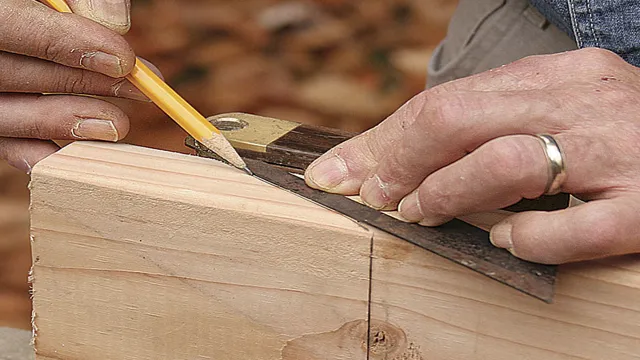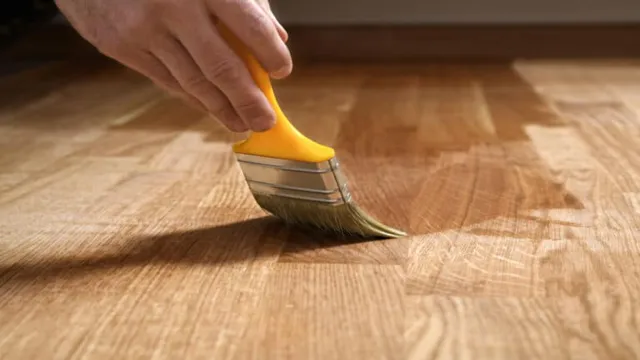How to Make Long Bevel Cuts: The Ultimate Guide for Precision Woodworking

Have you ever tried to make long bevel cuts and ended up disappointed with the results? Perhaps the angles were uneven or the edges were rough. Whatever the case may be, mastering the art of making long bevel cuts is a challenging but rewarding task. Whether you’re a professional woodworker or a DIY enthusiast, learning how to make long bevel cuts can take your projects to the next level.
But where do you start? What tools do you need and how do you use them? In this blog post, we’ll go over everything you need to know about making long bevel cuts. From choosing the right saw to following the correct techniques, we’ve got you covered. Think of making long bevel cuts like driving a car on a winding road.
You need to be precise and deliberate with your actions to avoid veering off course. With the right tools and techniques, making long bevel cuts can be as satisfying as hitting all the right curves on a scenic drive. So buckle up and let’s get started on your journey to perfecting the art of making long bevel cuts.
Introduction
Have you ever tried to make long bevel cuts but found it difficult to keep the angle consistent throughout the cut? It’s a common issue faced by many woodworkers, but there are a few techniques you can use to make the process easier. Firstly, it’s important to have the right equipment. A table saw or hand saw with a bevel guide will make it easier to achieve the desired angle and keep it consistent throughout the cut.
Next, practice makes perfect – start with shorter cuts and work your way up to longer ones to hone your technique. Another tip is to mark the angle on the wood beforehand using a protractor or angle finder, so you can follow the line with your saw. Remember to take your time and be patient – rushing the cut can lead to mistakes and uneven edges.
With these tips, you can confidently tackle long bevel cuts and achieve clean, precise results.
What are bevel cuts?
Bevel cuts are a type of angled cut made on a material’s edge, usually done with a saw or cutting tool. They are commonly used in woodworking, metalwork, and other industries that require precise cutting for a variety of applications. Bevel cuts can be made at different angles, ranging from slight to severe, depending on the project’s needs.
These cuts are useful for creating joints, edging, and decorative trim, among other things. Bevel cuts are typically made by tilting the material or the saw blade at a specific angle, allowing for the desired cut to be completed successfully. When done correctly, bevel cuts can produce clean, accurate results, making them a popular tool for professionals and hobbyists alike.

Why make long bevel cuts?
When it comes to woodworking, making long bevel cuts can serve a variety of purposes. From creating decorative edges to fitting and shaping pieces of wood together, there are many reasons why you might need to make a long bevel cut. Essentially, a bevel cut refers to an angled cut made along the edge of a piece of wood.
By adjusting the angle of the saw blade, you can create a bevel that slopes in one direction or the other. While bevel cuts can be made on shorter pieces of wood, there are times when you may need to make a long bevel cut across a longer board or plank. In this blog post, we’ll explore some of the common reasons why you might make a long bevel cut, as well as some of the techniques and tools that can help you achieve a great result.
Selecting the Right Tool
When it comes to making long bevel cuts, selecting the right tool can make all the difference. A circular saw or miter saw are both great options, but which one you choose depends on the specifics of your project. Circular saws are versatile and can be used for a variety of cuts, including long bevel cuts.
They are also portable and can be taken to job sites easily. On the other hand, miter saws are ideal for precise angled cuts and are especially useful for baseboards or crown molding. So, if you’re working on a project that requires long bevel cuts, consider the pros and cons of each tool to determine which one is the best fit for your needs.
Regardless of which tool you choose, make sure to take the proper safety precautions and wear appropriate protective gear when operating power tools.
Circular saw or miter saw?
When it comes to deciding between a circular saw and a miter saw, the choice can be difficult. Both tools have their strengths and weaknesses, and it ultimately depends on what kind of project you’re working on. A circular saw is a versatile tool that can cut through a variety of materials, such as wood, metal, and plastic.
It’s also portable, making it easy to maneuver and transport from one location to another. On the other hand, a miter saw is a precise tool that’s ideal for making angled cuts. It’s perfect for projects that involve molding, trim work, and cabinetry.
So, if you’re working on a project that requires angled cuts, a miter saw would be the way to go. However, if you’re looking for a more versatile tool that can handle a variety of materials, a circular saw might be the better option. Ultimately, consider the specific needs of your project before making a final decision.
Choosing the right blade
When it comes to choosing the right blade for your project, it’s important to select the right tool for the job. There are a number of factors to consider, including the material you’ll be working with, the type of cut you need to make, and the level of precision required. For example, if you’re working with a softwood like pine, a coarse-toothed blade will help you make quick cuts without damaging the wood.
On the other hand, if you need to make precise cuts in a hard material like metal or tile, a fine-toothed blade will give you the control you need to make accurate cuts. Ultimately, the key to selecting the right blade is understanding your project and the tools available to you. By doing your research and experimenting with different blades, you can find the perfect tool for the job and achieve professional-quality results.
Setting Up Your Saw
Are you looking to make long bevel cuts with your saw? The first step is to properly set up your saw to ensure accuracy and safety. Begin by adjusting the blade height so that it is above the material you will be cutting. Next, adjust the bevel angle to the desired degree.
It’s important to make sure that the blade is parallel to the guide fence to prevent any unwanted angle changes during the cut. You can use a square to check this before making your cut. Additionally, make sure that the material you are cutting is securely clamped to the table to prevent it from shifting during the cut.
By taking these steps to set up your saw, you will be able to make long bevel cuts with precision and ease.
Angle adjustment
Setting up your saw can be a bit overwhelming, but with the right steps, it’s a breeze. One of the most critical steps is adjusting the angle of your saw blade. For precise and accurate cuts, it’s essential to set the angle correctly.
Start by loosening the saw’s locking knob and adjusting the bevel gauge. From here, you can adjust the angle of your saw blade by moving the bevel gauge. Use a protractor or angle finder to double-check the angle and ensure it’s accurate.
Once you have the right angle, tighten the locking knob and make your cuts. Remember to adjust the angle as needed for different types of cuts. With a little practice, you’ll find it easy to adjust the angle of your saw blade in no time.
Blade depth adjustment
Adjusting the blade depth on your saw is an essential step in setting up your equipment to ensure precision and accuracy in your cuts. But how do you know the correct depth to set it to? Start by considering the material you will be cutting and the thickness of the blade. If you’re using an older blade that has become dull, it may require a lesser depth for it to produce clean cuts.
On the other hand, a new blade will require a deeper cut. You can adjust the blade depth by loosening the blade adjusting knob and moving the blade up or down until it reaches the desired depth. Once adjusted, retighten the knob to lock the blade in place.
Don’t forget to check the blade depth periodically, especially if you switch to a different material or blade. By taking the time to understand the importance of blade depth adjustment, you can guarantee that your saw operates effectively and produces the results you’re looking for.
Making the Cut
If you’re wondering how to make long bevel cuts, there are a few things you should keep in mind. Firstly, it’s important to use the right saw for the job. A circular saw is great for making long bevel cuts, as it allows for precise cuts and a straight line.
Before you start cutting, make sure you have marked out your cut line accurately, using a straight edge or other guide. It’s also important to use a good quality blade, as a dull or worn blade can lead to inaccurate cuts and even accidents. When cutting, take your time and let the saw guide itself through the wood, rather than trying to force it.
With a steady hand and a bit of practice, you’ll soon be able to make long bevel cuts with ease.
Safety precautions
Making the cut can be a risky business, which is why safety precautions are key. If you’re using a saw, make sure to wear eye protection and never put your fingers too close to the blade. When cutting with a knife, use a cutting board and keep your fingers curled under to avoid accidentally slicing them.
Always keep your tools sharp, as dull blades are more likely to slip and cause injury. And when it comes to power tools, make sure to properly secure the equipment and use safety guards as directed. Remember, a moment of carelessness can result in a lifetime of regret.
So take the extra time to ensure safety, and you’ll be able to make all the cuts you need without incident.
Technique for smooth cuts
Making smooth cuts is not just about having the right blade and equipment but also about getting your technique right. One essential technique you need to employ is keeping your saw blade completely stable as you begin your cut, and letting it go through the material without exerting any force that could distort your cut. If you are working with a handheld saw, ensure that it is firmly and comfortably set against your material before cutting.
Additionally, keeping your tools sharp and well-maintained will make your cuts smoother, improving the overall result of your work. Another important tip is to pay attention to the blade’s angle, as cutting at the correct angle ensures the material is severed cleanly and smoothly. Remember to maintain a steady pace as well, so as not to distort the blade’s movement, and to keep your hand firm but relaxed.
By mastering these techniques, you will be able to achieve consistently smooth cuts and significantly improve the quality of your finished work.
Finishing Touches
If you’re a woodworking enthusiast, you know that making long bevel cuts can be quite tricky. These types of cuts are typically used for finishing touches on furniture or woodworking projects, so it’s essential to get them right. The first thing you need to do is set up your saw correctly.
Make sure the blade is sharp and that the bevel angle is set to the correct degree. Then, measure the length of the cut and mark it on the wood. Next, make sure you have a clear line of sight so you can follow your line accurately.
Now, it’s time to make the cut. Start slowly and focus on maintaining a consistent speed and angle throughout the cut. Don’t rush the process or force the saw through the wood, as this can cause the blade to bind or kick back.
With a steady hand and a bit of practice, you’ll be able to make long, smooth bevel cuts with ease.
Sand or sandpaper?
When it comes to adding the finishing touches to a DIY project or renovation, one important decision you’ll need to make is whether to use sand or sandpaper. While both options can smooth out rough edges and create a polished finish, they have different levels of abrasiveness and are better suited for different applications. If you’re working with wood or a softer material, sandpaper may be the better choice as it allows for more consistent pressure and control.
However, if you’re working with a tougher surface, like metal or concrete, sand may be the more effective option. Ultimately, the key is to choose the right grit level for your project and to use even pressure throughout the sanding process to ensure a smooth and flawless finish. Whether you choose sand or sandpaper, taking the time to properly sand your project will ensure that it looks and feels professional.
Tips for a professional-looking finish
When it comes to giving your DIY project a professional-looking finish, it’s all about the little details. Here are some tips to help you achieve that polished look: Sanding: It might not be glamorous, but taking the time to sand your project thoroughly can make a big difference.
Use a fine-grit sandpaper to smooth out any rough edges or imperfections. Sealants: Applying a sealant or topcoat can protect your project from damage and give it a more finished look.
There are different types of sealants depending on the material you’re working with, so make sure to choose the right one. Trim: Adding trim can really elevate the look of your project.
Whether it’s baseboards, crown molding, or trim around a door, it’s an easy way to make your project look more professional. Paint: A fresh coat of paint can do wonders for your project.
Make sure to use high-quality paint and apply it evenly for a smooth finish. Remember, the key to achieving a professional-looking finish is to take your time and pay attention to the details. With these tips, your DIY project will look like it was done by a pro!
Conclusion
So, there you have it – the not-so-secret secrets of making long bevel cuts. From proper blade selection and tool placement to steady movement and patience, these tips will help you create clean, precise angles on your workpieces. And the best part? You can impress your friends and family with your newfound bevel prowess, all while enjoying the satisfaction of a job well done.
So go forth and bevel with confidence, my friends – the world is your angular oyster!”
FAQs
What is a bevel cut and why is it important in woodworking?
A bevel cut is an angled cut made across the thickness of a material. It is important in woodworking as it allows for the creation of angled edges on pieces, which can add visual interest and improve functionality.
What types of saws are best for making long bevel cuts?
Saws with longer blades, such as a circular saw or a sliding miter saw, are best for making long bevel cuts.
How can I ensure that my bevel cuts are accurate?
It is important to use proper measuring and marking techniques before making a bevel cut. Additionally, using a saw with a laser guide or a digital display can help ensure accuracy.
What is the best way to set the angle for a bevel cut?
Using a protractor or a bevel gauge can help accurately set the angle for a bevel cut. It is important to double-check measurements before making the cut.
Can bevel cuts be made on a table saw?
Yes, bevel cuts can be made on a table saw by adjusting the angle of the blade. However, it is important to use caution and ensure that the material is properly supported during the cut.
How can I make precision bevel cuts for intricate woodworking projects?
Using a scroll saw or a jigsaw with a bevel guide can help make precision bevel cuts for intricate woodworking projects.
Are there any safety precautions I should take when making bevel cuts?
It is important to wear safety glasses and appropriate clothing when making bevel cuts. Additionally, ensuring that the material is properly secured and using tools with safety features can help prevent accidents.







